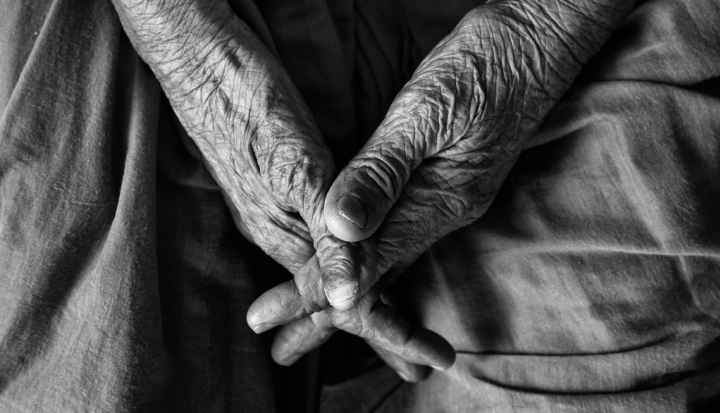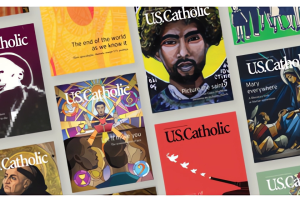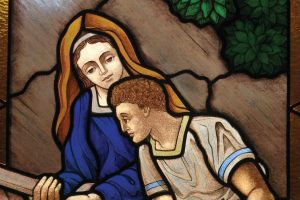Dad’s face was gaunt, with skin hugging his high cheekbones and gray stubble enveloping his chin and upper lip. His bony shoulders poked out from a baggy blue-plaid hospital gown, and his hands shook when he tried to raise them.
Just a month ago, we had been celebrating my birthday at a hibachi restaurant, where Dad’s only medical problem seemed to be his inability to hear conversation in such a noisy place. He sat at the end of the u-shaped table, with his good ear next to his granddaughter. Now, he was confined to a hospital bed on the oncology floor of a local hospital at the lowest point in a regimen of chemotherapy. He was suffering from the debilitating side effects of chemo drugs destroying the cancerous cells in a tumor just below his colon.
Although his speech barely rose above a whisper, the poetry he was repeating in an age-old cadence was clear: “Holy Mary, Mother of God, pray for us sinners now and at the hour of our death.” Thankfully, it was not the hour of his death—not then, and not today, eight months later. But during the worst hours of his life, he summoned the grace of Mary, chanting the prayer as a soothing meditation, humming the prayer as a soft lullaby, mouthing the therapeutic words when speech failed him.
It isn’t often that I see faith manifested in such a simple, unornamented way. During the deepest and darkest days of suffering, Dad turned to God—not to beg or bargain but to find solace from suffering and comfort from Catholicism. Witnessing his quiet faith in action brought me back the meaning of prayer in the very basics of life, death and faith.
Dad’s faith cleared away the clutter of my own Catholicism.
Although my parents have attended the same church for nearly four decades, I’ve never had much allegiance to any particular parish. Each time I would move to a new city in my 20s and 30s, I would attend Mass at each parish in the area until choosing the one where I felt the most comfortable, whether it was around the corner or out of walking distance.
Marriage and children have made my life less transient and more deeply rooted in our community, but I still attend Mass on Sunday at one of three very different churches in our area, favoring one, then another, then yet another, then back to the initial one. More than anything else, my temperamental relationship with each church hinges on the substance of recent sermons and the way the priests interact with parishioners and religious education directors interact with young families.
In fact, my most moving experience at Mass in recent memory wasn’t in any of those nearby churches but in one far away. Last summer, I attended 7:30 p.m. Mass with my husband’s mother in Puerto Morelos, Mexico, after the heat of the day had subsided and a gentle breeze brushed off the ocean. In the open-air building, the priest spoke in Spanish, a language I do not understand. I was lost when I tried to follow along, sentence by sentence, with the handout distributed in the pews. But when I stopped trying and simply sat and listened, the spiritual sincerity of the aging, smiling priest inspired me.
That day in the hospital, my father’s prayers reminded me that it doesn’t matter where I worship, or whom I pray with. It doesn’t matter if Mass is in my mother tongue or a language unknown to me. It doesn’t matter if the sermon is stirring or lackluster.
At middle age, I’ve realized what really matters: that our own prayers, the ones at the very core of our faith or personal petitions, are said and heard. What matters is the unassuming example that my parents have set throughout their long lives—grace before dinner, presence at Mass, homemade meals for people who are suffering, help for those with unmet needs.
And during those dire days in the hospital, Dad reflected on what, perhaps, matters most—God is compassionate and here for us in our hour of need, whether in a plain church in another country, an airy Gothic church in a suburb, a university chapel, a low-lying modern building in the woods, even amid the beeps and tangle of intravenous lines in a small hospital room.
Image: Flickr cc via Vinoth Chandar











